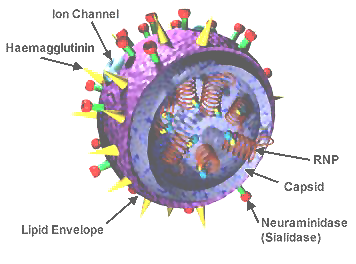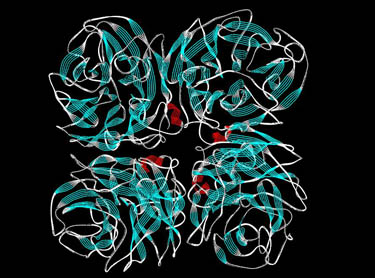|
How does Tamiflu Work?
About
Tamiflu -- General Information
| Tamiflu
(oseltamivir phosphate) is an antiviral drug marketed by the
Swiss pharmaceutical company Roche. It is a neuraminidase
inhibitors (similar to Relenza) and can shorten the duration
and lessen the severity of several types of influenza. |
|
|
Scientists
at Roche synthesize oseltamivir from shikimic acid, using a specific
type of star anise that grows in four mountain provinces (Guanxi,
Sichuan, Yunnan and Guizhou) of southwest China. The manufacture
of Tamiflu involves a complex, 10-step process that takes approximately
6-8 months to complete.
Tamiflu
can't stop the flu entirely. However, studies have shown that
if you take it within 48 hours of showing symptoms, it
can shorten the duration of the flu (strains A and B).
What
is the Target for the Tamiflu Drug?
There
are two molecules on the influenza virus surface that are critical
to its spread: hemagglutinin H and neuraminidase N. Neuraminidase
helps the flu virus break through the cell membrane so it can
move on to other cells and replicate itself.
Tamiflu
(oseltamivir) is an inhibitor of influenza neuraminidase that
binds to the enzyme active site.
NOTE:
Relenza (zanamivir) is also an inhibitor of influenza neuraminidase
that binds to the enzyme active site. (Relenza is GlaxoSmithKline's
trade name; zanamivir is the generic name.) Unlike Tamiflu, which
is given orally, Relenza is usually administered by inhalation,
or can be injected.
 |
Tamiflu
binds to the active site on neuraminidase (Sialidase).
Neuraminidase
helps the flu virus break through the cell membrane so it
can move on to other cells and replicate itself. Tamiflu
inhibits the neuraminidase protein, so that the virus can't
leave the cell to infect other cells.
Image
from Proteopedia.com
|
 |
Neuraminidase
is a homotetramer --Each of the four protein chains in the
tetramer has a catalytic site, and is able to bind Tamiflu
inhibitors.
The secondary structure is mostly beta, consisting of several
beta sheets with three short alpha helices (Beta Strands,
Alpha Helices). * The residues contacting the Tamiflu inhibitory
substrate analog are highly conserved
|
What
is the structure of the tamiflu molecule?
|
[Tamiflu structure shown using the JMol
Applet]
|
What
is the Structure of Tamiflu?
Try
this!!
Click
the right mouse button with the cursor over the image-->
Render
--> Schemes --> CPK Spacefill
Click
on the left mouse button and rotate the Tamiflu structure.
For
3-D Structure of Relenza click
here.
|
|
|
|

